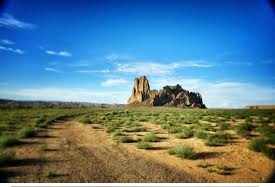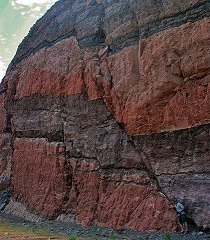Rocks that are in layers usually form when materials accumulate at the Earth's surface (depositional rock).

Rock beds usually represent an event of some sort.
These can be short and energetic (as for some sandstones) or long periods of quiet settling of materials (as for most mudstones and shales).
If the rocks are layered:
- How thick are the layers?
- How are the layers of different rock types arranged (alternating, clustered together)?
- Are there any patterns or trends in the layering that you can identify (do the proportions of rock types change vertically)?
- Are the upper and lower surfaces of each layer flat, undulating, irregular?
- Do the layers stay roughly the same thickness along their exposure?
- Are the boundaries between layers sharp or do they grade into one another?
Rocks that form less regular masses usually formed within the earth (intrusive) and conform to the shape of the cavity in which they formed.

- What shapes to the rock masses have?
- How large are the masses?
- Are they uniform internally?
- folding
- faulting
- tilting
- fracturing


Are they composed of grains or crystals?
Rocks composed of interlocking crystals suggest that the rock formed by cooling of molten material or precipitating from a solution.
Rocks composed of individual grains will have some gaps between between grains
Grains of material would be transported by wind or water and then settle out to eventually form the rock layer as they get cemented together.

Minerals are naturally occurring, solid chemical compounds
Rocks are assemblages of minerals
At this point in the course your probably can only describe what you see rather than identify.
- Are there several different minerals or just one?
- What are the proportions of each mineral as well as relative sizes of the grains or crystals?
- Are the minerals randomly arranged or are there any patterns (banding, orientation or crystal shapes, trends)?
These give valuable clues as to the type of processes and environment that produced the rock layer.

Are there any fossils within the rock layers (including fossil burrows and other indicators or animal activities)?
Are there any features on the upper and lower surfaces of the rock layers?
- ripples
- sratches and other marks made by debris carried by a current (especially on the lower surface)
- evidence of animal activity
The goal of the process of description is to produce a written and graphical description of the rocks in an outcrop.
